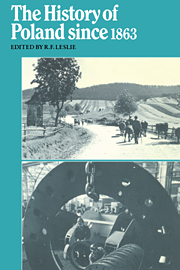Book contents
- Frontmatter
- Contents
- List of maps
- Preface to the paperback edition
- Abbreviations
- Map 1 Poland in the nineteenth century
- 1 Triloyalism and the national revival
- 2 Poland and the crisis of 1900–7
- 3 Poland on the eve of the First World War
- 4 The emergence of an independent Polish state
- 5 The breakdown of parliamentary government
- 6 Piłsudski in power, 1926–35
- 7 Poland without Piłsudski
- 8 Poland in defeat, September 1939–July 1941
- 9 The ill-fated alliance, August 1941–April 1943
- 10 The years of Tempest, May 1943–December 1944
- 11 Post-war Poland
- 12 The rise and ebb of stalinism
- 13 The October turning point
- 14 ‘The little stabilization’
- 15 The decline of Gomułka
- 16 Poland under Gierek
- 17 Polish society, 1945–75
- Epilogue: The rise and fall of Solidarity
- Notes
- Select bibliography
- Index
13 - The October turning point
Published online by Cambridge University Press: 26 December 2009
- Frontmatter
- Contents
- List of maps
- Preface to the paperback edition
- Abbreviations
- Map 1 Poland in the nineteenth century
- 1 Triloyalism and the national revival
- 2 Poland and the crisis of 1900–7
- 3 Poland on the eve of the First World War
- 4 The emergence of an independent Polish state
- 5 The breakdown of parliamentary government
- 6 Piłsudski in power, 1926–35
- 7 Poland without Piłsudski
- 8 Poland in defeat, September 1939–July 1941
- 9 The ill-fated alliance, August 1941–April 1943
- 10 The years of Tempest, May 1943–December 1944
- 11 Post-war Poland
- 12 The rise and ebb of stalinism
- 13 The October turning point
- 14 ‘The little stabilization’
- 15 The decline of Gomułka
- 16 Poland under Gierek
- 17 Polish society, 1945–75
- Epilogue: The rise and fall of Solidarity
- Notes
- Select bibliography
- Index
Summary
The Twentieth CPSU Congress
The Twentieth Congress of the Communist Party of the Soviet Union had been expected for some time, and it is known that on 27 and 28 January representatives of the people's democracies were forewarned that the congress would be critical of Stalin, but well before that date the agenda must have been circulated to the East European leaders, and it must have made clear that the congress would be a continuation of the New Course. The congress took place in Moscow between 14 and 25 February and was attended by foreign communist leaders. The Polish delegation consisted of Bierut, Berman, Zawadzki, Cyrankiewicz and Morawski. In his speech Bierut spoke of the deep love of Poland for the Soviet Union and the willingness of the PZPR to be guided by the experience of the CPSU. The main themes of the congress speeches and debates were already familiar ones of the New Course. The doctrine of different roads to socialism, invoked by Khrushchev in the summer of 1955, was endorsed and the possibility of a peaceful establishment of the communist system was also admitted. Otherwise the congress had little to say about communist parties or their relations with the CPSU. The past exploitation of the people's democracies was not referred to even indirectly. Nevertheless, the moribund Cominform, once Stalin's tool for imposing Soviet wishes on the people's democracies, was dissolved not long after the congress, on 17 April 1956.
- Type
- Chapter
- Information
- The History of Poland Since 1863 , pp. 344 - 366Publisher: Cambridge University PressPrint publication year: 1980



